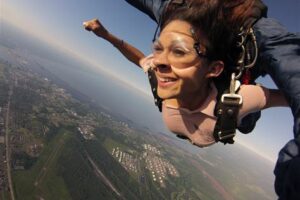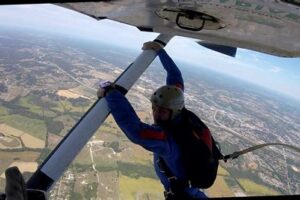Table of Contents
Learn about weight limits for skydiving and discover the maximum weight allowed to participate in this thrilling adventure. Find out the requirements set by skydiving centers and ensure you meet the necessary criteria. Prepare yourself for an unforgettable experience as you soar through the sky!
When it comes to the exhilarating sport of skydiving, there are a few factors that one must consider before taking the leap. One of the most crucial aspects is the weight limit imposed by skydiving centers. This limitation not only ensures the safety of the individual but also guarantees a smooth and enjoyable experience in the vast skies above. With careful consideration and adherence to the weight limit, aspiring skydivers can embark on an unforgettable adventure that will leave them breathless and craving for more.
Introduction
Skydiving is an exhilarating adventure that many people dream of experiencing at least once in their lifetime. However, just like any other extreme sport, there are certain safety considerations that need to be taken into account. One of the most important factors is weight limit. In this article, we will explore the weight limits for skydiving and why they exist.
Understanding Weight Limits
Skydiving centers enforce weight limits to ensure the safety of both the skydiver and the instructor involved in the jump. These limits are set based on various factors, including the equipment being used, the parachute’s performance capabilities, and the experience level of the instructors. By adhering to weight limits, skydiving centers can minimize the risks associated with the activity.
Typical Weight Limits
While weight limits may vary slightly between different skydiving centers, the general rule of thumb is that the maximum weight for a skydiver is usually around 220-230 pounds (100-105 kilograms). This weight includes the gear that the skydiver will be wearing during the jump. However, it’s important to note that some facilities may have lower weight limits due to specific equipment restrictions or local regulations.
Reasons for Weight Limits
There are several reasons behind the weight limits imposed by skydiving centers:
Gear Capacity
The gear used in skydiving, such as harnesses and parachutes, are designed to accommodate a certain weight range. Exceeding these weight limits could put excessive strain on the equipment, compromising its effectiveness and potentially leading to accidents.
Freefall Speed
The weight of the skydiver affects their freefall speed. Heavier individuals fall at faster speeds, while lighter individuals fall more slowly. Maintaining a consistent freefall speed is crucial for effective parachute deployment and safe landings. Weight limits help ensure that the freefall speed remains within a manageable range.
Instructor Capability
The instructors who accompany skydivers are highly skilled professionals who are trained to handle certain weight ranges. By adhering to weight limits, skydiving centers can ensure that instructors can safely manage and control the jumps, reducing the risk of accidents or injuries.
Implications of Exceeding Weight Limits
If an individual exceeds the weight limit set by a skydiving center, they may be prohibited from participating in the activity. Attempting to skydive while exceeding the weight limit can compromise the safety of everyone involved. It’s essential to respect these limits to prioritize the wellbeing of both the participant and the instructors.
Alternative Options
If someone is unable to participate in skydiving due to weight restrictions, there are alternative options available to still enjoy the thrill of flight. Indoor skydiving facilities, also known as vertical wind tunnels, provide a similar experience of freefalling without the need for weight limits. This is a fantastic alternative for those who want to experience the sensation of skydiving.
Conclusion
Weight limits for skydiving exist to ensure the safety and enjoyment of all participants. By understanding and respecting these limits, both skydivers and instructors can have peace of mind knowing that they are engaging in a thrilling adventure while minimizing unnecessary risks. Whether you meet the weight requirements or explore alternative options, the experience of skydiving is sure to be an unforgettable one.
Understanding Weight Restrictions
When it comes to skydiving, weight restrictions are put in place for safety reasons. Skydiving operations have set weight limits to ensure that the parachute system functions properly and can safely carry the individual during the jump. It is crucial to understand and adhere to these weight restrictions for a smooth and secure skydiving experience.
Importance of Weight Limits
Weight limits play a critical role in skydiving as they directly impact the aerodynamics and stability of the jump. Exceeding the weight limit can compromise the functionality of the parachute and harness system, increasing the risk of accidents or parachute malfunctions. Adhering to the weight limits ensures a controlled descent and enhances the overall safety of the skydiver and those around them.
Factors Influencing Weight Limits
Several factors influence the weight limits for skydiving. These include the type and size of the parachute, the descent rate, the strength of the parachute’s suspension lines, and the handling characteristics of the parachute system. Additionally, the altitude at which the skydive takes place and the weather conditions can also impact weight limits. Thus, understanding these varying factors is essential to determine the appropriate weight limit for each individual.
Standard Weight Limits
While weight limits might vary slightly between different skydiving centers, the industry standard weight limit for tandem skydiving is typically around 220-240 pounds (100-109 kg). This weight limit takes into account the specific equipment used for tandem jumps, ensuring that the parachute system can accommodate the weight of two individuals safely. However, it is essential to check with the skydiving center beforehand, as certain centers might have lower or higher weight limits depending on their equipment and safety protocols.
Heavyweight Skydiving Options
Individuals who exceed the standard weight limit for tandem skydiving may have alternative options available to them. Some skydiving centers offer specialized equipment and training for heavyweight individuals, allowing them to experience skydiving safely. These options typically involve the use of larger parachutes and modified harness systems, ensuring the adequate support and stability required during the jump.
Communicating with the Skydiving Center
To ensure a safe and enjoyable skydiving experience, it is crucial to communicate your weight accurately with the skydiving center during the booking process. Being transparent about your weight will allow the center to make the necessary arrangements, determine if any alternative options are available, and ensure that the equipment provided is suitable for your weight range.
Weight Restrictions and Health Conditions
In addition to weight limits, certain health conditions may affect an individual’s ability to skydive safely. It is important to inform the skydiving center about any relevant health conditions or concerns before booking your jump. They will be able to assess the situation and provide guidance on whether it is safe for you to participate in skydiving or if any additional measures need to be taken to ensure your safety.
Promoting a Healthy Lifestyle
Maintaining a healthy lifestyle and staying within the recommended weight limits for skydiving will not only ensure your safety during the jump but also enhance your overall skydiving experience. Engaging in regular physical activity and maintaining a balanced diet can contribute to an optimal weight range for skydiving, allowing you to fully enjoy the thrill and excitement of this adventurous activity.
As a professional in the field of skydiving, I firmly believe that implementing weight limits is an essential safety measure that should be strictly adhered to. Skydiving is an exhilarating adventure sport that requires careful planning, meticulous training, and adherence to safety protocols. The imposition of weight limits serves as a crucial component in ensuring the well-being of both the skydiver and those involved in the activity.
Here are some key points supporting the necessity of weight limits in skydiving:
- Safety First: The primary reason behind setting weight limits for skydiving is to maintain the safety of all participants. The equipment used in skydiving is designed and tested to support specific weight capacities. Going beyond these limits can compromise the integrity of the gear, leading to potential accidents or malfunctions during the jump. By adhering to weight limits, skydiving operators can mitigate risks and ensure a safe experience for everyone involved.
- Adequate Control and Stability: Weight limits also play a significant role in maintaining control and stability during a skydive. Proper weight distribution is crucial for achieving stable body positioning in the air. Exceeding weight limits can make it challenging for instructors and participants to maintain the desired posture, increasing the risk of uncontrolled spins or instability during the freefall. Adhering to weight restrictions allows for better control and enhances the overall experience for skydivers.
- Equipment Performance: Skydiving equipment, including parachutes and harnesses, undergo stringent testing and certification processes to ensure they can handle specific weight ranges. Overloading the equipment by surpassing weight limits can strain the materials and compromise their performance. By respecting weight limits, skydivers can have full confidence in the reliability of their gear, reducing the likelihood of equipment failure and potential accidents.
- Operational Efficiency: Setting weight limits enables skydiving operators to efficiently manage their resources and infrastructure. From aircraft capacity to parachute inventory, these limits help ensure that the necessary provisions are in place for a safe and successful skydiving experience. Abiding by weight restrictions allows operators to plan and execute jumps more effectively, maximizing the enjoyment and safety of all participants.
In conclusion, weight limits in skydiving exist for valid reasons and should be taken seriously by both participants and operators. Prioritizing safety, control, equipment performance, and operational efficiency are paramount in this high-adrenaline sport. By adhering to weight limits, skydivers can focus on the sheer joy and excitement of the experience while minimizing unnecessary risks.
Thank you for visiting our blog and taking the time to read our article on weight limits for skydiving. We understand that the topic of weight restrictions can be a sensitive one, but it is important to prioritize safety when engaging in any adventure sport. In this closing message, we would like to summarize the key points discussed in the article and provide some final thoughts.
To begin with, it is crucial to acknowledge that weight restrictions exist for skydiving for the safety of both the participants and instructors. The equipment used during a skydive, such as the parachute and harness, are designed to support a certain weight range. Going beyond these limits can put excessive strain on the equipment, increasing the risk of failure and potentially endangering lives. Additionally, the physics and mechanics of a skydive can be affected by weight, and it is necessary to ensure that the jump can be executed safely.
It is important to note that weight limits can vary depending on the drop zone and the type of skydive you choose to undertake. Typically, the upper weight limit for tandem skydiving ranges from 200 to 240 pounds, although there are drop zones that accommodate individuals who weigh more by using specialized equipment. It is advisable to check with your local drop zone to understand their specific weight restrictions before planning your skydiving experience.
In conclusion, while weight limits for skydiving may seem restrictive, they are in place to prioritize safety and ensure a successful and enjoyable experience for all involved. If you find yourself above the weight limit, it is essential not to take it as a personal setback but rather as an opportunity to focus on your health and well-being. By working towards a healthier weight, you can not only increase your chances of participating in skydiving but also enhance your overall quality of life. Remember, skydiving will always be there, waiting for you when you are ready to take the leap!
Thank you once again for being a part of our blog community. We hope that this article has provided you with valuable insights into the weight limits for skydiving. If you have any further questions or would like more information on this topic, please feel free to reach out to us. Happy skydiving!
Video Weight Limit To Skydive
Here are some common questions that people also ask about weight limits to skydive:
-
What is the weight limit to go skydiving?
-
Why do skydiving centers have weight restrictions?
-
Can I skydive if I am over the weight limit?
-
Are there any exceptions to the weight limit for skydiving?
-
How does weight affect skydiving safety?
Answers to these questions:
-
The weight limit to go skydiving varies depending on the skydiving center. However, it commonly ranges between 200-240 pounds (90-108 kilograms) for tandem skydiving, where you are connected to an experienced instructor who guides the jump.
-
Skydiving centers have weight restrictions primarily for safety reasons. The equipment used during a skydive is designed and certified to hold specific weight limits. Exceeding these limits can compromise the integrity of the equipment and pose risks to both the skydiver and the instructor.
-
If you are over the weight limit set by a skydiving center, it is unlikely that they will allow you to skydive. Safety is their top priority, and exceeding weight limits can impact the effectiveness of the parachute system and increase the risk of accidents. It’s important to respect their guidelines and focus on finding alternative activities that can provide a similar adrenaline rush.
-
Some skydiving centers may make exceptions to weight limits on a case-by-case basis. This usually depends on factors such as the availability of specialized equipment, experience level of the skydiver, and the assessment of the instructor or dropzone. It’s best to contact the specific skydiving center directly to inquire about any exceptions they might offer.
-
Weight plays a crucial role in skydiving safety. The parachute system is designed to handle specific weight ranges to ensure proper functioning and landing. Exceeding these limits can affect control, stability, and the ability to land safely. Weight limits also consider the strength and experience of the instructors, who need to manage the additional load during tandem jumps. Adhering to weight restrictions helps maintain the highest level of safety for all participants.
Remember, it’s always important to consult with the skydiving center directly for their specific weight limit requirements and any additional information they may have.






